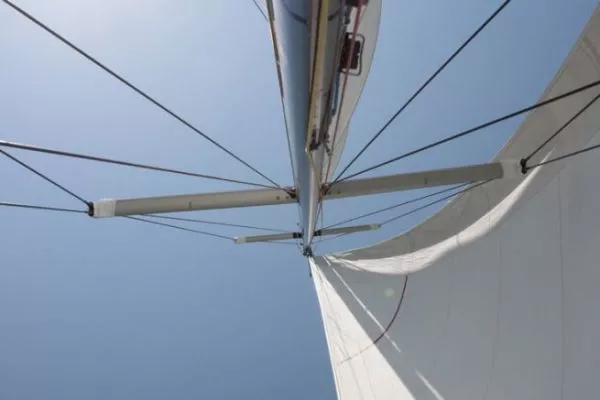The Importance of Standing Rigging in Sailing
Standing rigging is a fundamental aspect of any sailboat, playing a critical role in supporting and adjusting the mast. It encompasses the fixed cables that keep the mast stable and ensure safe sailing. Every cable within this system bears a specific name and function, understanding which is vital for optimal performance on the water.
In today’s world of modern sailboats, standing rigging forms a cohesive network that keeps the mast in position, influencing the sails’ shape and the overall stability of the vessel. These components constantly hold tension, distinguishing them from running rigging, which adjusts sails in response to wind conditions. Below is a detailed look at key elements of standing rigging crucial for a sailor’s knowledge.
1. Strut: Longitudinal Forward Support
The strut, or forestay, connects from the masthead to the bow of the boat. It counteracts the backward force exerted by the backstay and typically serves as an attachment point for the headsail, such as a genoa or jib. The positioning of the strut, depending on whether the rigging is head or split, influences the mast’s angle and the shape of the headsail.
2. Backstay: Rear Tension
Running from the top of the mast to the stern, the backstay serves to balance the tension between the forestay and mast. Some yachts incorporate a double backstay or even hydraulic systems for easy adjustments. In specific rigging configurations featuring pushed spreaders, the backstay’s tension does not impact the mast’s permanent bend or rake, with only shroud settings influencing these factors.
3. Forestay: Support for the Lower Part of the Mast
The forestay, affixed lower than the main forestay, connects the midsection of the mast to the foredeck. Its primary role is to limit how much the mast can bend backward in rough seas, especially on fractional rigs, adding stability when navigating choppy waters.
4. Cap Shrouds: Lateral Mast Support
Cap shrouds run from the deck to the masthead, providing lateral stability to the mast. These long cables, often referred to as V1, V2, and V3, depending on their specific spreader levels, are critical for maintaining the mast’s verticality, preventing it from buckling sideways.
5. Lower Shrouds: Low Lateral Stability
Fixed at the first spreader level, lower shrouds stabilize the lower section of the mast, preventing it from bending under lateral forces. Adjusting these shrouds can influence the stiffness of the mast and the way forces distribute between the upper and lower shrouds.
6. Inter: Intermediate Link
The inter connects an intermediate point on the mast with an associated chainplate, completing the shroud configuration. This component stabilizes precisely between two sets of spreaders, maintaining the rig’s geometry.
Exploring the World of Sailing and Rigging
Understanding these crucial elements is essential for any sailor, whether navigating serene lakes or the open ocean. The awareness of how each piece functions not only enhances safety but also improves overall sailing performance. As the world of boating continually evolves with technology and techniques, it becomes even more vital for sailors to stay informed about the latest rigging practices.
At GetBoat.com, the passion for sailing and exploring the coastlines goes hand in hand with the commitment to keeping clients updated on relevant trends in sailing and vacationing on the water. The feeling of freedom that comes from sailing—discovering new inlets, bays, and lagoons—transforms every journey into an adventure. Select a vessel tailored to your likes and budget, and enjoy the ocean as never before.
The Benefits of Understanding Standing Rigging
Here are some reasons why comprehending the standing rigging’s elements is beneficial for sailors:
- Enhanced Safety: Knowing how rigging works ensures safer sailing experiences.
- Improved Performance: Understanding tension adjustments maximizes sail efficiency.
- Maintenance Awareness: Recognizing wear points helps prevent equipment failure.
Each sailing voyage is more than just reaching a destination; it is about immersing oneself in the rhythm of life at sea. As a sailor, one learns to appreciate the culture and natural beauty present in each location visited. From the unique aspects of local cuisine to architectural wonders, understanding rigging further enriches the sailing experience.
If planning your next seaside adventure, consider boat rentals. Each location offers a distinct narrative, much like the flavors of local food or the charm of a seaside village. Experience these narratives firsthand, and let GetBoat.com help you find the perfect vessel for your journey anywhere along the coast.
Conclusión
In summary, standing rigging comprises vital components essential for stabilizing a sailboat’s mast. A thorough understanding of these parts goes hand in hand with the experience of sailing, bringing both excitement and peace. GetBoat.com remains committed to providing opportunities for unforgettable boating adventures, ensuring transparency and convenience in all interactions. Whether renting a yacht or a sailboat, clients can easily navigate the myriad of options available and select one that suits their needs. Experience the ocean’s embrace as you embark on your next sailing journey. Join the community of boat enthusiasts and make every moment count!


